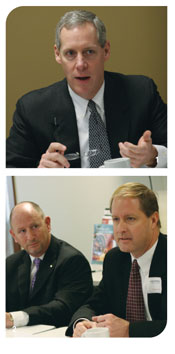“The good news,” added Patrick Pribyl of Lockton, “is that 2006 was by far and away the best year the surety industry has had in a while.” The top tier players are making good money. The future, as Pribyl explained, looks bright for that group in terms of their commitment to underwriting and profitable business.
Pribyl expressed concern about some of the big mega-projects either going up or in development. He cited the state of Missouri’s anticipated bridge design-build project, a large cement plant in St. Louis, and the water park project planned in Wyandotte County. Those are the kind of projects—the $500 million and above kind—that the surety industry has trouble with.
“Beyond that,” he added, “I think times are good for the large to middle-market segment.”
Minority Hiring
As Ernie Straub noted, contractors have been working hard but not always successfully to meet minority-hiring commitments, especially those mandated by the city of Kansas City, Missouri. “Does anyone have any answers here?” Straub asked.
Don Greenwell with the Builders’ Association explained the two kinds of minority recruitment issues that contractors face. The first is the more traditional kind: minority business enterprises and women business enterprises. These regulations most contractors are all familiar with. The criteria with MBEs and WBEs are more ownership than workforce.
What’s come in to play more recently, particularly at Kauffman Stadium, Arrowhead, and TIF projects in Kansas City, has been what Greenwell calls “field utilization”: the race and gender makeup of those working out in the field and only in the field. “Those numbers for the stadiums were, frankly, arbitrarily set.”

1: Grover Simpson of Lockton Companies reports on the diminishing number of insurance companies that once served larger construction projects and the inherent challenges associated with such.
2: Don Greenwell of the Builders' Association reports on the regulations associated with hiring minority business enterprises as well as women business enterprises. Event chair and host Ernie Straub with Straub Construction observes.
To make life more complicated for the contractor, there are about twelve categories of crafts with distinct percentages for each. Greenwell charitably described these percentages as “goals,” not “mandates.”
As the contractors realized, it is more socially productive to solve minority hiring issues at the supply end rather than at the demand end. “We need the minority participation in the workforce,” said Scott Kelly of Taylor Kelly. “And we need to start it at the grassroots level.”
“It needs to be a concerted, public and private initiative,” Greenwell agreed. He referred specifically to programs like those of the National Institute for Construction Excellence, which brings their curriculum right into the schools. Greenwell believes that if particular school districts like Kansas City, Missouri’s could get involved, “In short order we could bring in significant numbers of women and minorities into the construction field.”
Dan Oxler of US Engineering Company spoke highly of a program called Project Prepare. “The people of Project Prepare were way above the quality that we normally get through our normal application process,” said Oxler. “We were extremely happy to get the deal.”
Permitting
The various requirements for minority hiring are just one part of the “permitting” process, all of which slow a given project down. “The review times are terrible,” said Doug Fogel. “It’s not just Kansas City, Missouri. It’s pretty much any municipality in the metro area.”
“I guess it’s too much to expect for the authorizing bodies to remain steadfast in their commitments to certain items during the processes,” said Roger Meyer, Meyer Brothers. “The rules keep changing and the requirements keep moving. It’s very frustrating for us.”
(...continued)